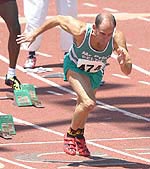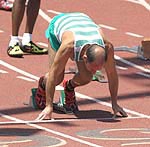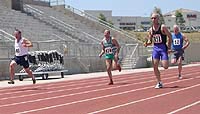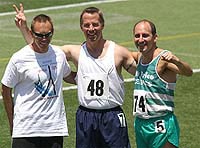 |
||||
| Posted November 12, 2004 | ||||

Photo by Jeffrey Sitcov
Hillel Katzeff drives from the blocks at the California State Games in his adopted home of San Diego in July 2004. He'd pull a muscle near the finish but still record an excellent 12.15 for his M45 age group.
|
Sprinting for his life: Running for my life By Hillel Katzeff "Speedy Gonzalez" was my nickname growing up in Cape Town – the city of my youth. Whether running to the corner store and back with my big sister holding the stopwatch, or participating in races on Sports Day in elementary school, running was my expression of freedom. By my teenage years, I began to take running seriously and developed my own training and fitness routines. I focused on the sprints and fortunately won a fair share of titles for my high school and provincial teams. When I came to the States, the competition got stiffer but I made it to the state competition in Iowa and later as a member of the track and field team at Muhlenberg College where I earned my varsity letter for three years. After graduation, I moved to New York City to attend business school in the early '80s. While jogging through the park one day, I noticed what felt like bone spurs in the heels of both of my feet. Rest did not help. The pain not only continued but, curiously, spread to my fingers and toes. It was only after visiting four or five different doctors that I was diagnosed with Psoriatic Arthritis, a condition that affects some five percent of all arthritis sufferers. It is genetic, incurable and can be triggered by stress. My condition continued to deteriorate and the pain continued to exacerbate. Soon I stopped exercising altogether. At first I felt angry and defiant and wondered: What I had done to deserve this? Eventually, I resigned myself to the fact that I had to live with this deforming and crippling disease – and that I might never be able to run again. It did not help when well-intentioned friends occasionally reminded me of my running days and how fast they remember me to be. At one point, I resorted to using a walking cane when the pain became unbearable and my balance was affected.
In an attempt to alleviate the stress that was worsening my condition, I chose to moved to San Diego in 1990, which fancies itself America's Finest City and isn't far from wrong. The climate was constant and warm, and so much like Cape Town that a large expatriate South African community has developed. It felt comfortable, like going home. One of the first things I did upon arriving in San Diego was to visit the tartan running track at UCSD. I even took out my running spikes and tried running a curve. Sadly, the warm sunny days in San Diego didn’t result in an immediate improvement of my health as I had hoped for. The pain was too much and I quit. Fortunately, the unsightly psoriasis did diminish somewhat during summer months. But the patches of dry, scaly and flaking skin would soon reappear on my knees and elbows during the cold winter months. The persistent pain was never far away. Over time, at random intervals, one by one, joints in my fingers and toes would be attacked. I would experience sharp shooting stabbing pain when one of these joints were touched or squeezed. I didn’t look forward to greeting people by shaking hands. And when the swelling subsided and the pain abated after a few months, these joints would be left bent, deformed and twisted – in a word: beaten. Seeking to make sense of my fate, I attended an arthritis support group for a few meetings. But that depressed me even more. I felt that I had no right to complain seeing people much worse off than I. I read up about the disease, consulted with medical specialists and made halfhearted efforts at changing my diet and lifestyle. But the pain felt like it had a vice like grip on me that I couldn’t seem to loosen. My energy was being sapped and my motivation was at a low ebb. Mornings were the worst. It would take me a few minutes of flexing my hands and feet before I would feel like getting out of bed. When I did, I would shuffle slowly to the bathroom on the soles of my feet that felt more like a bed of nails. My doctors called me stoic.
Returning from a visit to family in London, I contracted a very bad flu and lost about 20 pounds. I hated traveling because I knew that I would feel worse after returning. I knew that I had to do something. One of my main reasons for moving to San Diego was the Pacific Ocean – one of the big benefits to living in paradise. I loved the water and while boogie boarding at La Jolla Shores, a couple of surfers cut me off and called me a "speedbump." I was fuming; no one would call me a "speedbump."If you can’t beat 'em, join 'em, so it was at that very moment that I decided to learn how to surf. I bought a used 9-foot-long board and a wet suit and learned by watching other surfers, even though at times it was often painful just walking across the sand to the water. Being part of nature and away from the stresses of work helped me to temporarily forget about my pain. Even when the waves were small, I enjoyed sitting on my board floating over the gentle swells. I liked the salty taste, could feel the warmth of the sun through my black wet suit and observed the incredible beauty all around me, including the cliffs rising above Blacks Beach. Imagine the Endless Summer poster coming to life each day with huge sunsets of magnificent hues of reds and oranges deepening into pinks and violets before slowly sinking behind the horizon. My routine of heading down to the beach for a session after work was my therapy. When there was no surf, I would find myself drawn to the swimming pool. Swimming was boring, but after a while I learned to appreciate the challenge and enjoy the constant 81 degree Fahrenheit water temperature. Not only did swimming give me a greater workout than surfing alone, it also helped my body slowly regained some long-lost definition. This in turn gave me a much-needed boost in self-confidence. My rheumatologist, a swimmer himself, would encourage me to keep up my swimming. However, no matter how fit I got, I could never break through the ever-present nagging pain always occupying a space in my consciousness. During a routine office visit to my doctor, I expressed my frustration about the continuous dull aching pain that I had been experiencing and enduring for years. I mentioned to him that a friend of mine had had some success with a relatively new medication call Enbrel. Over the years, I had tried many types of drugs with none having the desired effect. He prescribed the medication, in conjunction with low doses of another medication called methotrexate, which is most commonly used as an anti-cancer drug. I had tried it years before with only limited success. It took a few weeks, but I noticed a significant lessening of the pain. After a couple of months I found that instead of the pain continuously occupying a part of my brain, I now had free space to think about other things. This was a new experience. It was the first time in about twenty years when I could say that I wasn’t aware of constant pain. Sure I would have the odd aches and pains, but it was nothing and unrelated to my disease. I recognized the opportunity in front of me — the chance to get health and stay that way. My memories of running as a youth soon returned and the possibility of running again became real. San Diego has a very active Master Track and Field circuit and local track clubs. It didn’t take me long to set my goal. I discovered the California State Games – an Olympic Games-styled competition – was scheduled to be in San Diego. The men’s 100 meters sprint competition was to be run on Friday, July 16, 2004. I had been twenty-two years since I had run a 100 meters race in competition. I had to do it. After sharing my dream with my wife and close friends, I began training in earnest. I didn’t have much time with only about seven months to race day. It was very exciting. I could hardly believe that I was uttering the words myself. Running again. My eyes welled with tears. I dared to believe and now I hoped my body would hold up. In my mind I was already running the race, but my body was definitely far from being in running, let alone sprinting shape. I was unsure of how my body would respond to the rigors of a full training schedule. I asked my doctor for his advice and he said I should go for it – but that I should listen to my body. Yet while my objective was to run in the race – my heart reminded me to stay true to myself and my mission: to take advantage of this window of good health, get into better shape and maintain it for as long as possible. The first day on the track after joining the San Diego Track Club, I could hardly finish a 150-meter run-through. My running was ungainly and I felt awkward. But I had only one goal and I focused on it like a laser beam. To help me, I put a team together. Besides my coach, I hired a personal fitness trainer and a massage therapist. Soon I need the services of my best friend, a retired physical therapist. He was also my biggest booster – second only to my wife, Linda. I incorporated everything into focusing on my goal. I used a gift certificate sent by sister to buy a pair of running spikes. They are very cool looking with a sleek red and black design. They even look fast – kind of like seeing a parked sports car. I changed my diet. No more the usual bagel, egg and cheese every morning. I became conscious of what I put in my body. After all, it was the fuel to help me win my race. Hot oatmeal sprinkled with blueberries or some other fruit is now my favorite. I drink tea now instead of coffee. I know that these lifestyle changes are not temporary; I believe that I have changed my life. With only a few short months left to get into sprinting shape, I became highly focused and disciplined. I trained 6 days a week for months. I felt a newfound confidence emerging. I had the feeling that I could accomplish almost anything. It became apparent that setting a goal and working toward it was beneficial in many ways. My body started to transform from being fit to being athletic, but not without setbacks. While I didn’t experience pain in my joints, even during the most vigorous of strength training exercises, I did pull calf, hamstring and other dormant muscles. As part of my visualization exercises, I would think of prior successes and try to relive them in order to experience that winning feeling again. I even contacted and received permission from my old track club in South Africa to run in the club’s gear – green and white. The club president remembered me from my high school days and I remember him taking an interest in me as a youngster.
A few weeks prior to the main race, I had run in a warmup race (left). During that race, I placed third in the 100 meters but had strained a hamstring muscle. Regardless, I was determined to rehab and make the Cal State Games my race. I met some incredible people during that meet. There was a sprightly 91-year-old man who ran the 100 meters for 90-94-year-olds and who told me that he had started running at 76. The week of the race, I was feeling good and confident. I felt that I was about to do something that was incredibly meaningful to me in my life and nothing was going to stop me from competing. The years I endured pain could be put in perspective. And with any luck, could be put behind me. Life, like a river, has many twists and turns. During the months of training and preparation leading up to the race, the focus had been on me – my training, my ups and downs, my aches and pains and injuries. All that changed in a flash. With three days to go before my race, Linda became ill with an acute abdominal pain. The focus on what was really important shifted instantly and radically. I rushed her to the ER. A year and half prior to that night, she had spent about nine weeks in the hospital with an incredibly painful bowel obstruction. Her symptoms that night were all too familiar. Mercifully, the quick action of the hospital staff and her doctors allowed her time to rest, resulting in a quick recovery. She returned home after spending two days in the hospital. I had planned my race for months and had run it many times in my head. But now the race no longer seemed important. I decided not to run so I could be present for Linda and our children. But it was Linda who encouraged me to run. Using the visualization techniques I had learned, I had to refocus on doing my best. The following day was the race. Driving to the track that Friday morning, I thought about how far I had come in such a short time – how I had dared to dream about sprinting again – and how today was the day. While excited, after the week I had had, I wasn’t nervous. It was a hot day, close to 90 degrees on the track. The sun was relentless and there was no shade. I warmed up well and kept hydrated by sipping water. There were only a few spectators in the stands. But at the finish line was a colleague from work and Linda. It was my turn to race. I slowly approached my starting blocks in lane 7 – looking at the finish line down the rubberized red tartan track. Stretching one last time I got comfortably into the starting position. My fingers and thumbs formed two pyramids right behind the starting line, my head hung forward – my breathing was relaxed. I kept my focus, blocking out everything and listening for the sound of the gun. I got off to a very good start and kept low during the first 20 meters before coming up into an upright running position in full stride. Being in a full sprint is controlled power. I felt the rush of air past my ears, but was oblivious to the sound. My hands were slicing through the air. Out of my peripheral vision I could see that I was among the leaders. I held my form. I was pushing my body to its limit. My head was steady and face relaxed. My arms were fluid and I felt my legs rapidly turning over. I thought to myself: "I’m going to make it." With 10 meters to go, my hamstring pulled and I literally popped up and lost precious time. Instantantly I knew I had to continue and complete the race regardless of the injury. I toughed out the remaining 3 or 4 steps. I finished second with a time of 12.15 seconds. I did it!
While being blessed with a window of good health, I am determined to achieve a greater state of health and not take it for granted. Today my goal is to maintain my good health for as long as possible. My off-season training is preparing me for next year when I want to run injury free and lower my time.
Looking back, I can remember how much of a struggle it was for me to get out of bed in the morning. Now my routine is to work out six days a week, every week. I enjoy yoga, swimming, running and working out in the gym. Leading a full balanced life. I feel good about being consistent and I am proud of my accomplishments so far. I don’t know if the medication will lose its efficacy over time. I neither know what the future holds nor whether the pain will reappear. Right now, I am pain-free. I am grateful. I feel blessed. Thinking about it, I would like to believe that my best defense against the disease is a good offense. I can only hope that the changes I have made to my lifestyle, maintaining a positive frame of mind and the advances of medical technology will help me stay a few steps ahead of it.
|


